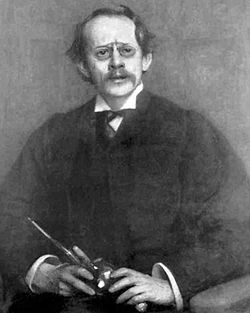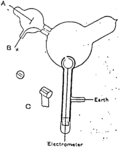J. J. Thomson
Sir Joseph John "J.J." Thomson, OM, FRS (18 December 1856 – 30 August 1940) was a British physicist and Nobel laureate. He discovered the electron and isotopes, and invented the mass spectrometer. He won the Nobel Prize in Physics in 1906 for his discovery of the electron and his work on how electricity works in gases. Joseph John Thomson in 1893 said: "There is no other branch of physics which affords us so promising an opportunity of penetrating the secret of electricity."
J. J. Thomson | |
|---|---|
 Sir Joseph John Thomson (1856-1940) | |
| Born | 18 December 1856 |
| Died | 30 August 1940 (aged 83) |
| Nationality | British |
| Alma mater | University of Manchester University of Cambridge |
| Known for | Plum pudding model Discovery of electron Discovery of isotopes Mass spectrometer invention First m/e measurement Proposed first waveguide Thomson scattering Thomson (unit) |
| Awards | Nobel Prize for Physics (1906) |
| Scientific career | |
| Fields | Physics |
| Institutions | Cambridge University |
| Academic advisors | John Strutt (Rayleigh) |
| Notable students | Ernest Rutherford Francis William Aston J. Robert Oppenheimer William Henry Bragg Max Born T. H. Laby Paul Langevin Balthasar van der Pol |
| Signature | |
 | |
| Notes | |
Thomson is the father of Nobel laureate George Paget Thomson. | |
In 1897, Thomson showed that cathode rays were made of a previously unknown negatively charged particle of very small mass compared to its electric charge. It was later called the electron and was the first subatomic particle to be found. Thomson also found the first evidence for isotopes of a stable (non-radioactive) element in 1913, while studying anode rays (positive cations).
In atomic theory he suggested the idea that atoms were spheres of evenly spread positive charge, where an individual negatively charged electron resided. He later concluded there was more than one negatively charged particle in an atom.
Many of the young men who studied and worked with him at University of Cambridge also became famous physicists.
J. J. Thomson Media
Autochrome portrait by Georges Chevalier, 1923









